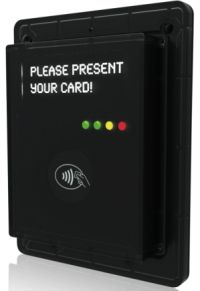The following are news announcements made during the past week by the following organizations:
Impinj;
FEIG Electronics;
Invengo;
Checkpoint Systems;
r-pac International and Truecount;
Swirl Networks.
Impinj Intros New RFID Chips, RFID Reader System-in-Package
Impinj has introduced three new products: Monza R6-P, Monza S6-C and the Indy RS2000 RFID reader SiP (system-in-package). All three items, which were unveiled at the recent RFID Journal LIVE! 2015 in San Diego, comply with RAIN RFID, ISO 18000-63 and EPC Gen 2 standards for passive UHF RFID tags and readers.
The Monza R6-P and the Monza S6-C are tag chips compliant with EPC Gen2v2 standard. The Monza R6-P chip is optimized for serializing items such as apparel, electronics, cosmetics, pharmaceuticals, jewelry and various other products, according to Impinj. It features read sensitivity of up to -22.1 dBm with a dipole antenna, a write sensitivity of up to -17.3 dBm, and up to 128-bits of EPC memory, a 48-bit serialized TID and up to 64 bits of user memory. With the Impinj ItemEncode software, the Monza R6-P offers encoding throughput up to 9,500 tags per minute.
The S6-C chip was designed from the ground up for deploying secure ticketing and metering solutions, according to Impinj. The chip features a fail-safe one-way counter, making it suitable choice for applications such as transit, parking, events and consumables. It offers a read sensitivity of up to -22.1 dBm with a dipole antenna and write sensitivity of up to -17.3 dBm. It has 96-bits of EPC memory, a 48-bit serialized TID, 32 bits of user memory and encoding throughput up to 9,500 tags per minute using the Impinj ItemEncode software.
The Indy RS2000 is a reader chip designed to be easily embedded into a device, requiring only connections to a power source, digital communication with a host, and an antenna. The package design allows it to be attached to a PCB using standard surface mount technology (SMT), with no need for additional connectors or mounting hardware, according to Impinj. The RS2000 is capable of reading hundreds of tags per second at distances greater than 10 meters when using a 6 dBi reader antenna and far-field passive tags, the company says. Its small form factor, 38.5 by 52.5 by 4.3 millimeters, enables a diverse range of applications, such as inventory management, portal readers, POS solutions, access control, process control in industrial automation, medical equipment, and performance handheld readers.
FEIG Electronics Debuts cVEND, a Secure Contactless Payment and Ticketing System
FEIG Electronics, a manufacturer of RFID readers, antennas and passive RFID tags, has introduced its cVEND contactless payment systems designed for integration in validation terminals of buses and trains, onboard computers and ticket gates. cVEND provides open-loop ticketing for check-in and check-out functionality by using contactless credit cards, and devices can be used in parallel for each form of closed-loop ticketing, using classic RFID tickets, which are purchased before departure, according to the company.
Officially launched at the recent RFID Journal LIVE! 2015 in San Diego, cVEND works with contactless credit cards (tap and go payment without signature or PIN), NFC-enabled smartphones with payment apps and also contactless tickets (such as VDV-KA, ITSO and Calypso).
The system is available in three variants: the cVEND plug, which can be seamlessly integrated into validation terminals; the cVEND box, which can be mounted in any kind of metallic kiosk-type systems, terminals and ticket gates; and the cVEND box+, which includes a display. Each is certified according to EMVCo Level 1 and Level 2 as well as PCI PTS 4.x. Users can choose between two integration methods, either running their own applications on the controller with the Linux version, or with cVEND as a transparent reader using their own controller.
FEIG Electronics has also included a Linux 3.10-based software developer’s kit (SDK), which enables secure management for applications and data, an easy-to-use application programming interface (API) for hardware and card interfaces, and a contactless API for secure payment transactions and data exchange with contactless tickets.
The cVEND products are currently deployed in beta test sites, with full production release and availability in June 2015.
Invengo Markets RFID Anti-Counterfeiting Labels in the U.S.
RFID technology manufacturer Invengo Technology Corp. has announced that its anti-counterfeiting RFID labels are now available outside of China. The announcement came earlier this month at the recent RFID Journal LIVE! 2015 in San Diego.
The tamper-resistant ultra-high frequency (UHF) RFID labels have been available in China and used for tagging and authenticating high-value Chinese liquor, wine and tobacco. The XC-TF8033 label operates at 902 MHz to 928 MHz and supports the RAIN, EPC Gen2 (v 1.2.0) and ISO 18000-6C standards. It features a tamper-proof design with an alarm function for privacy protection and security, and has been optimized for use on plastic bottle caps, containers, packaging, paper documents, cardboard cartons and glass, according to Invengo. The Product Status Flag (PSF) function means that the digital flag can be repeatedly set and reset to indicate whether the product has passed quality checks or whether it has passed through a specific process checkpoint/ The PSF function can also be used in conjunction with an electronic anti-theft system (EAS), to indicate whether a piece of tagged merchandise was purchased or not. A read protection function consists of 32-bit password that can be repeatedly reset. The label supports a 128-bit EPC, a 64-bit TID, 32-bit access password and 32-bit kill command, Dense Reader Mode, and operating temperatures of -40 degrees to +85 degrees Celsius. Each label offers data retention of 20 years and a write endurance of 10,000.
The label measures 20 millimeters by 30 millimeters by 0.20 millimeters and features a silver ink antenna. There are 2,000 inlays per roll, with 12 rolls per order. Invengo says each label goes through various rigorous property and parameter testing to ensure product stability and reliability before leaving the factory.
“We see this tag will impress brand owners wanting to give their consumers greater confidence in the products’ authenticity. High-value food and beverages can be protected and we expect to see many of the tags going back into China on imported products as many consumers are already used to having this seal of authenticity,” Sio Peng Goi, market director at Invengo, said in a prepared statement.
Checkpoint Systems Announces RFID Upgrade Kit for EAS Applications
Checkpoint Systems has announced an RFID upgrade kit that’s designed to provide a smooth migration to RFID for retailers using Checkpoint’s EVOLVE iRange P10 electronic article surveillance (EAS) antennas, the company says.
The Checkpoint RFID Upgrade Kit includes one EPC Gen 2 UHF RFID reader and two sets of reader antenna. The reader is equipped with Checkpoint’s Wirama software to start RFID-based electronic article surveillance (EAS) and it can also connected to OAT Software Foundation for more data analytics.
The upgrade kit is fitted by Checkpoint Systems service technicians to existing or new P10 antennas. According to Checkpoint, the upgrade kit requires authorized and certified (factory trained) Checkpoint field representatives to install and upgrade Checkpoint EAS deployments, and virtually all of Checkpoint’s North American customers use Checkpoint field service reps for remedial maintenance, as well.
Once upgraded via the new kit, the EVOLVE iRange P10 antennas enable Checkpoint’s “one tag” approach so retailers can use a single RFID tag for inventory visibility and loss prevention. The antennas also provide support for differentiated alarms based on the quantity and/or value of the merchandise leaving the store; and support for Checkpoint’s patented Wirama Radar for tag-read accuracy, directionality and location, the company says. The Wirama technology can distinguish whether an item is simply being merchandised near an exit or is potentially being stolen, and enables retailers to place merchandise closer to exit doors, minimizing the risk for false alarms.
“Technology should make life easier for both consumers and retailers,” Uwe Sydon, senior VP of innovation for Checkpoint Systems, said in a prepared statement. “Checkpoint’s RFID upgrade kits accomplish this, with simple implementation and proven loss prevention and merchandise availability benefits that help everyone.”
The upgrade kits are available immediately.
R-pac International Acquires Truecount Item-level Tracking Software
RFID, trim and packaging solutions provider r-pac International has announced it has acquired Truecount Corp.‘s cloud-based solution for item-level tracking in the supply chain via radio frequency identification. In bringing Truecount software under its umbrella, r-pac has formed a new division, r-trac Retail Services. The software solutions and services offered by this new r-pac division will be marketed as r-trac Retail Services powered by Truecount, and will include best-in-class tags, and tag commissioning, hardware and software designed to meet the specific needs of each customer. Truecount will be involved the new organization, according to r-pac.
The new division is designed to be a one-stop, single resource for retailers and the retail supply chain, according to r-pac. “The addition of Truecount’s portfolio to that of r-pac’s establishes the most complete and powerful software solutions for the retail and retail supply chain RFID needs,” r-pac’s CEO, Michael Teitelbaum, said in a prepared statement. “With all the components for a successful deployment under one roof, r-pac has the capability, and flexibility, to support any business model while maximizing RFID’s efficiencies for end users.”
According to r-pac, the new software and services can be used to create RFID-enabled real time location systems that help warehouses and data centers more accurately locate and track inventory to improve item management, simplify pick-and-pack processes, validate pre-pack shipments, validate that items are out the door and on the correct trucks, and receive electronic proof-of-delivery with instant alerts to missing or wrong merchandise for every delivery. The software and services provide complete compliance with RFID mandates, r-pac says.
For retailers, the software and services can provide continuous real-time visibility of inventory, accurate reads through packaging and crates with the ability to read thousands of items in minutes, and store-wide inventory management of all areas, including storage areas, dressing rooms and customer carts, according to r-pac. They also can be used to provide shrink control, with precise, actionable data on what is happening to each piece of merchandise as it moves through the supply chain, through the store, and out the door, and enable quicker replenishment processes.
Bluetooth Beacon Platform Provider Swirl Closes $18M Investment
Swirl Networks, provider of an in-store mobile marketing platform that leverages Bluetooth beacons, has announced that it has raised $18 million in equity financing from Hearst Ventures, SoftBank Capital, Longworth Venture Partners, Twitter Ventures and other strategic investors.
The Series C round brings Swirl’s total funding to date to $32 million, and the new capital will be used to expand Swirl’s sales and marketing operations and to fuel investment in product innovation to meet demand from retailers and brand advertisers for beacon-powered indoor mobile advertising.
Swirl’s platform is designed to help retailers and brands deliver information and offers to customers’ smartphones while they shop at participating retail locations nationwide. The information and offers are based on customers’ specific in-store location and behavior, as determined by the use of Bluetooth beacons installed in those stores. One of Swirl’s customers is Alex and Ani, a jewelry and apparel retailer that deployed beacons at all 40 of its branded stores in 2014 (see Alex and Ani Rolls Out Swirl’s Bluetooth Beacons at 40 Stores).
“The caliber of strategic investors and partners in this round validates the immense potential that proximity-based indoor mobile marketing has to transform the advertising and retail landscapes,” Hilmi Ozguc, founder and CEO of Swirl, said in a prepared statement. “Swirl is helping leading retailers, publishers and brand advertisers bridge the physical and digital worlds in a way that was never before possible. This new investment gives us unmatched resources to accelerate our efforts and extend our leadership position in this exciting space.”




